Some of the links in this post may be affiliate links.
If you’re looking for a gigantic, statement plant for your garden, look no further than Colocasia Thailand Giant. Previously classified as a Colocasia, this strain of elephant ear is super-sized to put it mildly. The correct botanical name is Leucocasia gigantia ‘Thailand Giant’.
Keep reading to find out how to care for this plant, and I will also share my own experiences of growing this giant in my own garden.
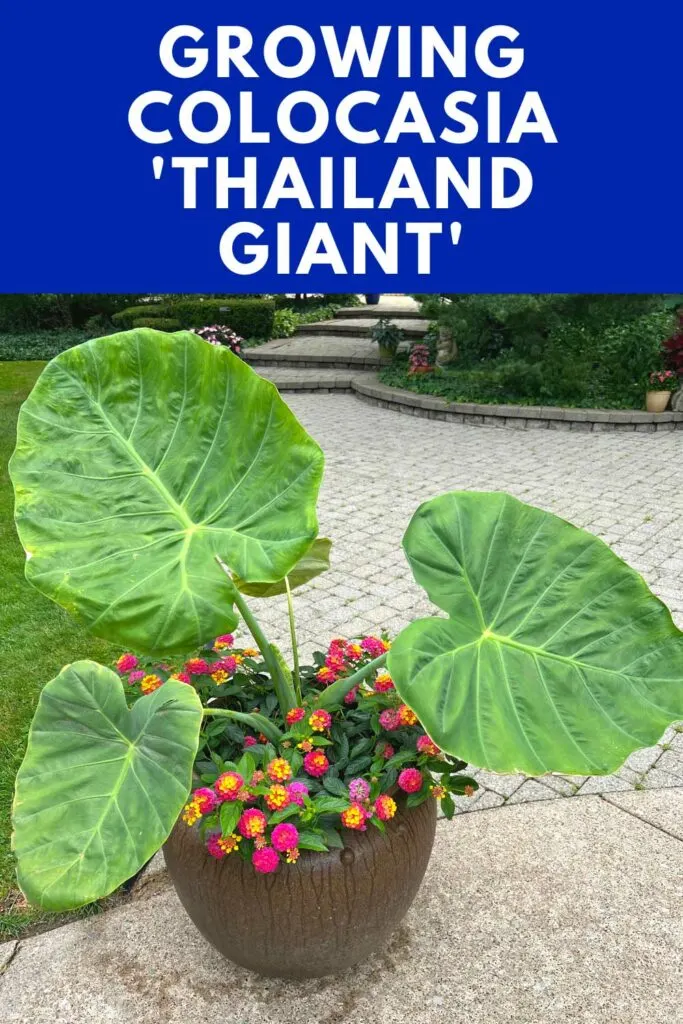
Table of Contents
ORIGIN OF COLOCASIA THAILAND GIANT
Where does this plant originate from? Wild collected seed was gathered from the Kanchanaburi Province in Thailand, by Petra Schmidt, a former research manager at Plant Delights Nursery, and used to develop a stock of this plant.
In the wild, the plant will reach about 9 feet tall with absolutely massive leaves. The leaves will approach 4-6 feet long and 3-5 feet wide. Grown in your home, the plant will likely be smaller but still very large!
It is native to several countries in southeast Asia where it grows in semi-tropical monsoon forests.
COLOCASIA THAILAND GIANT CARE
Here are my experiences with growing this plant in my own garden. Even if you live in an area with a short summer, the growth rate of this plant is truly incredible and it will lend a wonderful tropical vibe to your garden.
To give you an idea about how quickly this plant grows, take a look at the photos below.
The photo below is shortly after planting it in mid-May. The plant only had two small leaves when I received it.
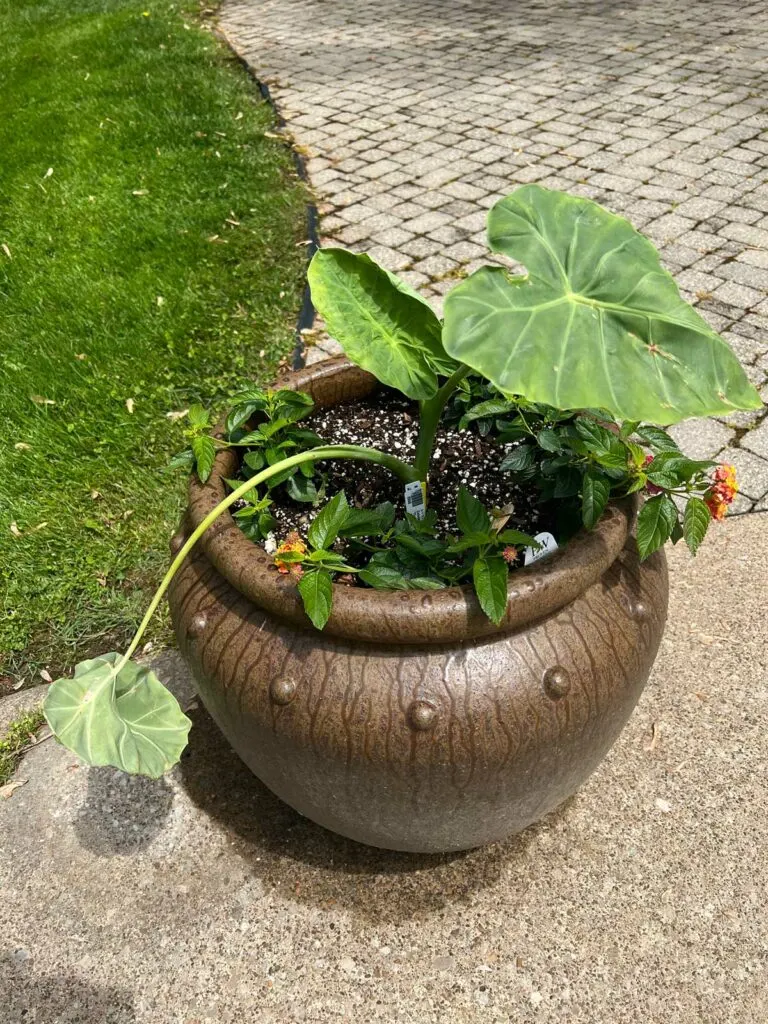
Just two months later, in mid-July, the plant had already grown tremendously.
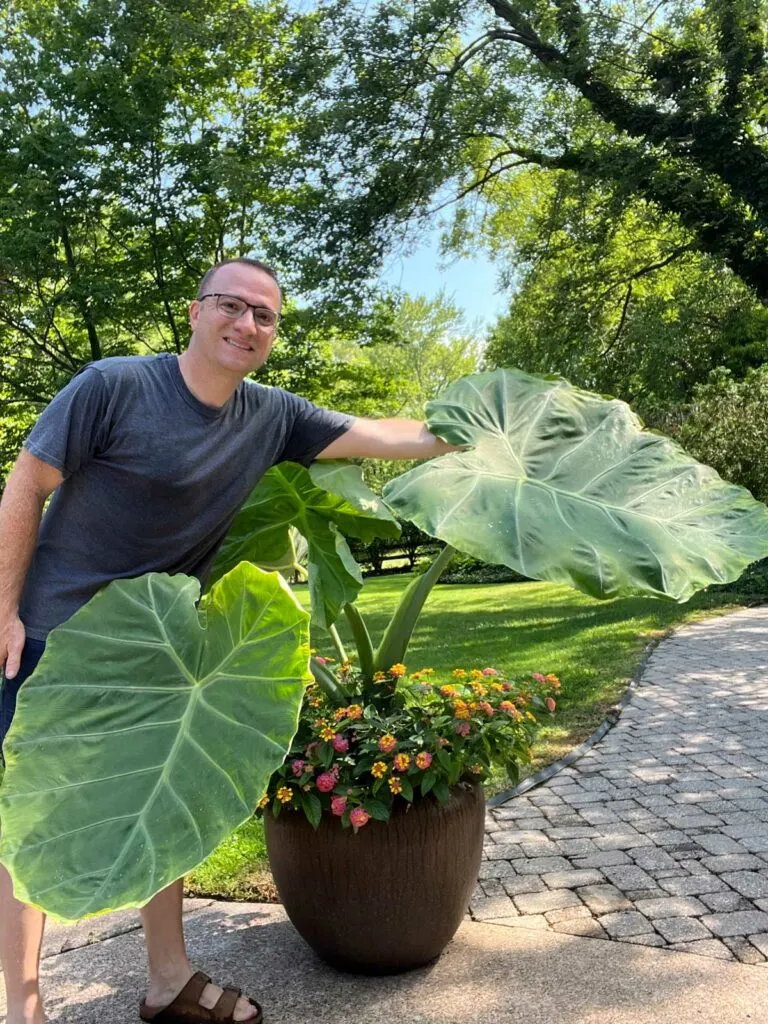
1. LIGHT
‘Thailand Giant’ is a sun loving plant, so give it the sunniest spot that you have in your garden, whether you are planting it in the ground or in a pot. The more sun the better.
If you live in a very hot climate, it may be best situated in partial shade.
If you can find an area that has sufficient sun, yet provides some protection from the wind, this would be ideal as the gigantic leaves can easily get torn and tattered with excessive wind.
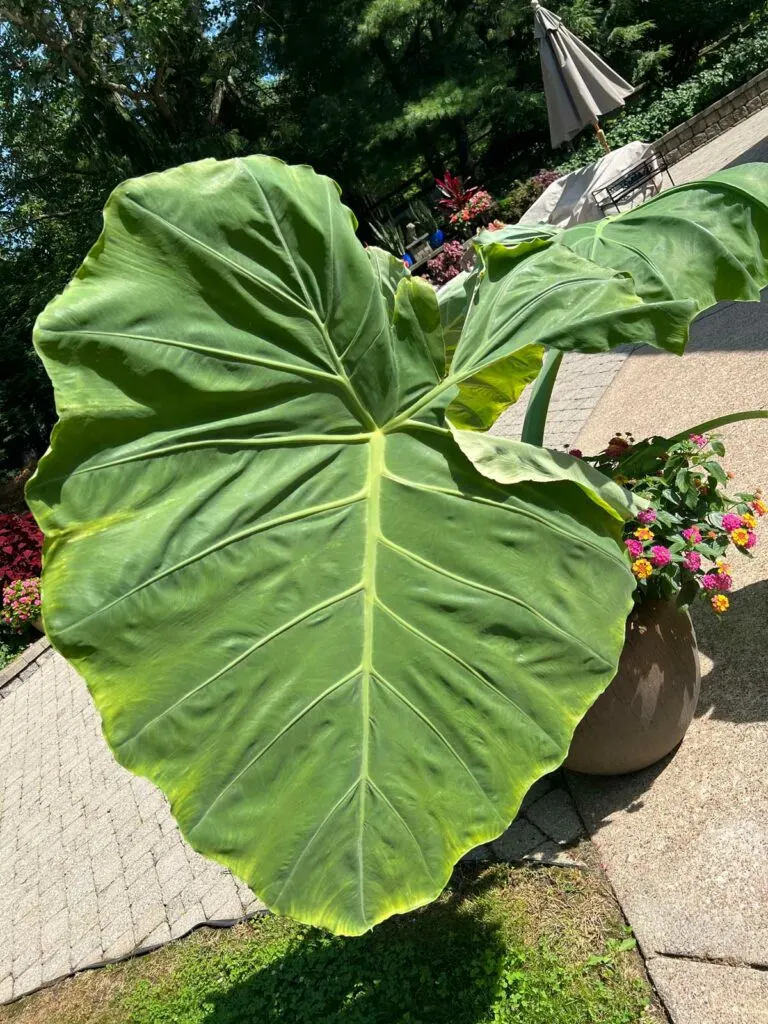
2. WATERING
This is a moisture loving plant and it is imperative that you never let your plant completely dry out.
If you’ve ordered a small plant, be careful not to keep it too wet at first. Once the growth starts taking off, you can water profusely.
Until growth really starts to take off, allow the top inch or two of the soil to dry out before watering again.
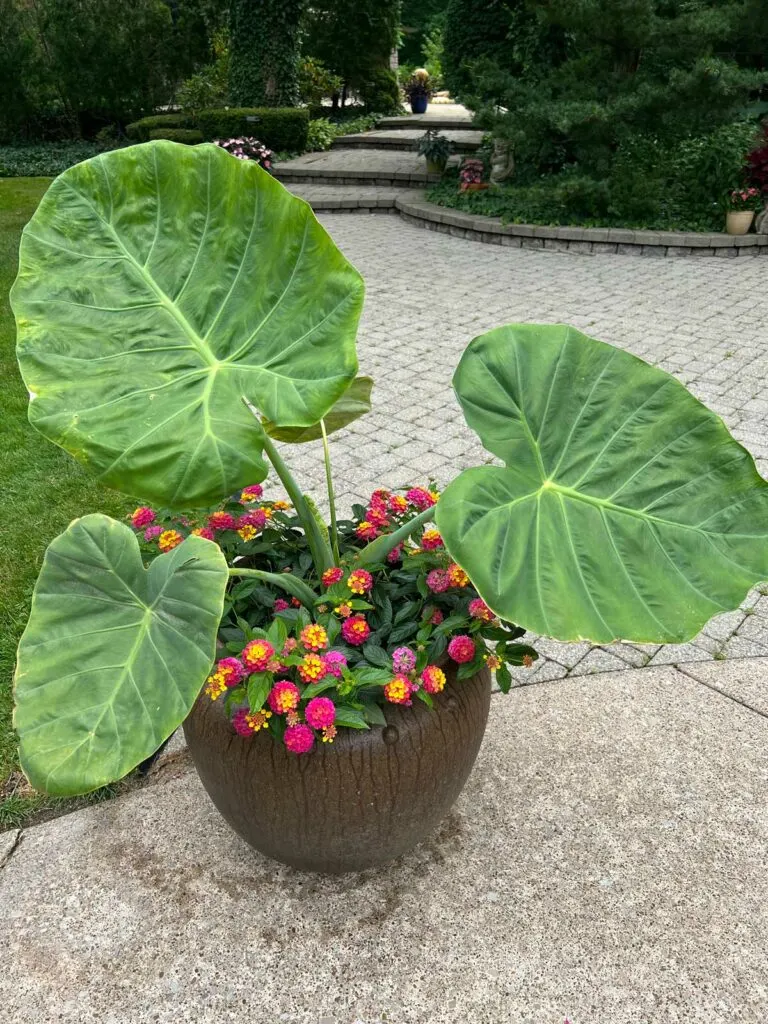
During the heat of summer, I water daily.
3. SOIL & POT
I potted my plant in large ceramic pot (18 inch diameter and 20 inches tall) using ProMix and some additional perlite in order to improve drainage.
Plant Delights Nursery recommends gradually increasing the pot size until you get to your final pot size. My plant is shipped in a 3.5 diameter pot. They recommend moving it to a 6 inch pot, and once growth takes off, you can then place it in a 15 inch diameter or larger pot.
I skipped this process and potted it immediately into a large pot. I was careful with watering, as I mentioned in the previous section, and everything worked out just fine.
I would recommend a very heavy, ceramic pot and avoid plastic, lightweight pots if you can. Once the plant starts growing, the giant leaves can really catch the wind and be prone to be knocked over if your pot is not heavy enough.
If you’re planting it in the ground, this plant loves moist, very fertile soils with plenty of organic content (such as compost and manure) mixed in.
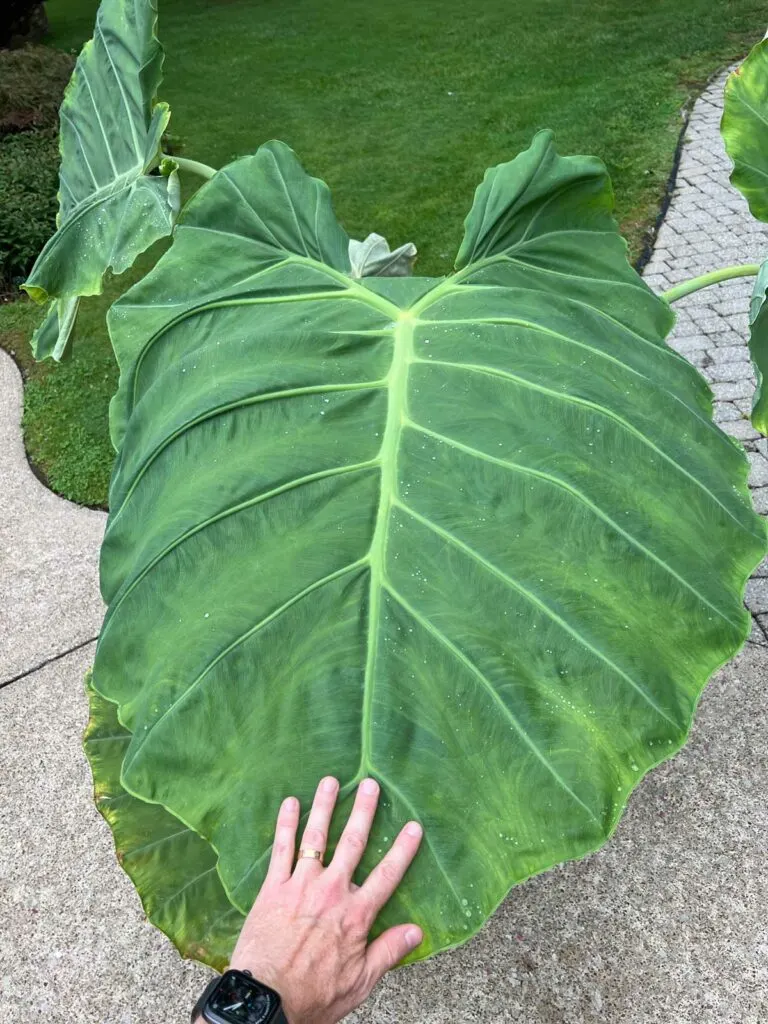
4. FERTILIZATION
These plants are very rapid growers, especially as temperatures heat up, so regular fertilization is important.
I’ve been alternating between Miracle Gro and Fish Emulsion and will fertilize every week to two weeks.
5. TEMPERATURE & HARDINESS
These plants grow best in hot and humid conditions.
If you live in a frost free climate, your plant will stay green year-round and will not need any protection.
If you’re at least in 8 zone, but experience frost, you will want to mulch your plant for the winter if you have your plant in the ground.
Once the foliage dies back in the fall after a frost, remove any dead foliage and mulch with about 6 inches of shredded leaves.
If you plant ‘Thailand Giant’ in the ground, be sure that the location has excellent drainage. Poor drainage and cold winters will spell death for this plant.
When warmer spring temperatures come, you can remove the mulch. Don’t be surprised if your plant doesn’t come back up until summertime. It is notoriously late to emerge.
Growth will be fastest when temperatures are warm and in the 80s F.
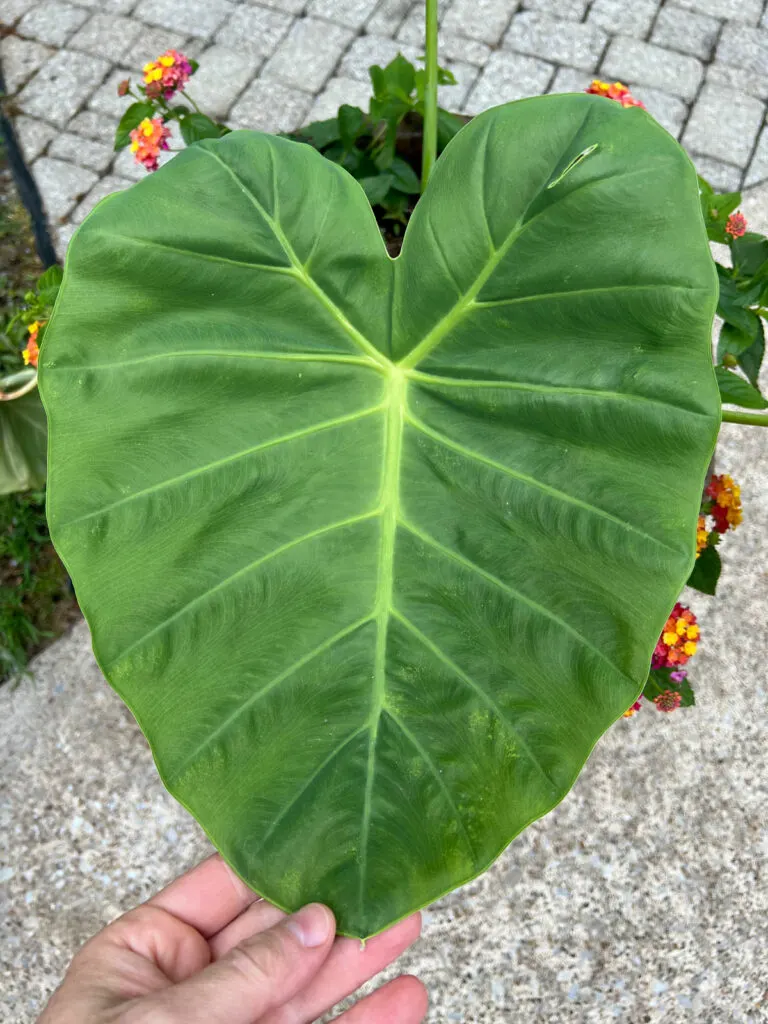
6. OVERWINTERING
In growing zones colder than zone 8, you’ll have to save and overwinter the tuber. I live in zone 6a so I definitely have to overwinter it in a safe place.
You could even try and move your plant indoors or in a greenhouse to keep it growing, but I find that it’s not really practical due to the sheer size of the plant!
Once frost has killed the foliage, here is what you can do with your potted plant:
- Cut the dead foliage off.
- Move the pot into a cool, dark location for the winter. Aim for a dark location with temperatures no colder than 45°F (7°C) and preferably no warmer than 60°F (15°C).
- Stop all watering for the winter.
- Once springtime comes and temperatures are consistently above a minimum of 50°F (10°C) or so, you can move your pot back outdoors and coax it back into growth. Go easy on the watering until growth starts. You can even give it a head start indoors or in a greenhouse if you’d like.
It is recommended to keep the tuber in the pot when you overwinter it. But you can also dig up the tuber, let it dry out for a couple days, and store in dried peat moss in a dark, cool, frost-free location as described above. This is similar to how you’d overwinter dahlias or cannas.
I will update this post to show the progress on overwintering my plant.
FLOWERING
I wasn’t sure if this plant would bloom in my short growing season in Northeast Ohio, but it certainly did! It produced the first inflorescence in early September.
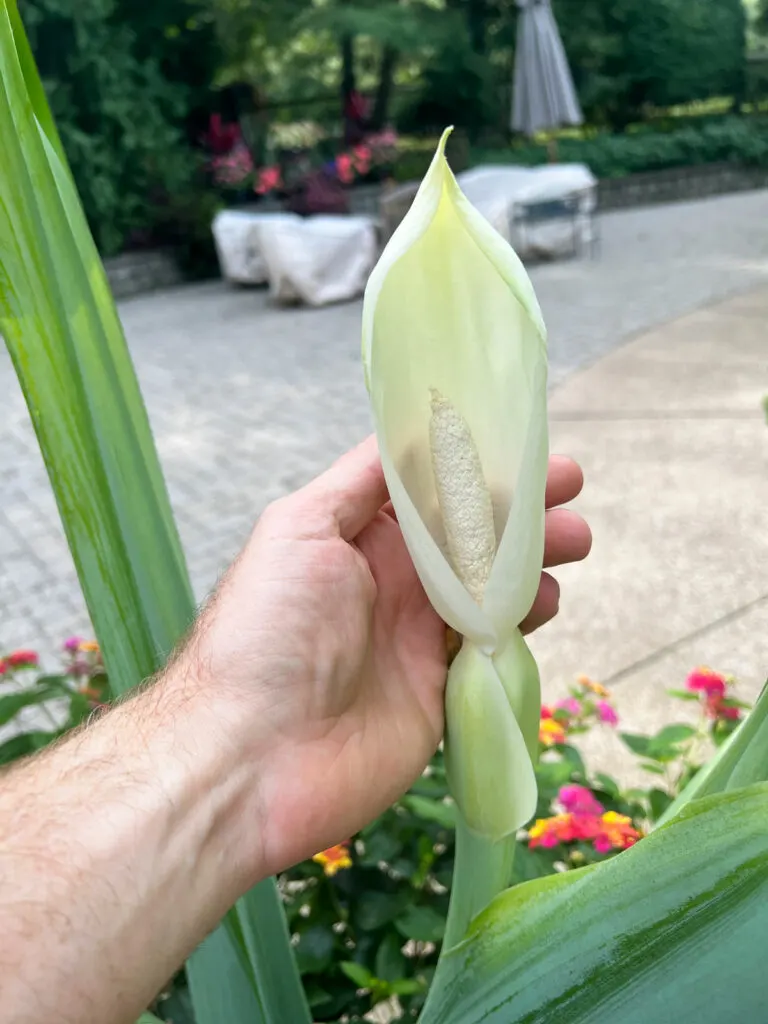
I actually pollinated this one (but my seasons probably isn’t long enough to finish maturing, but it was fun to try and actually watch the pollination take.)
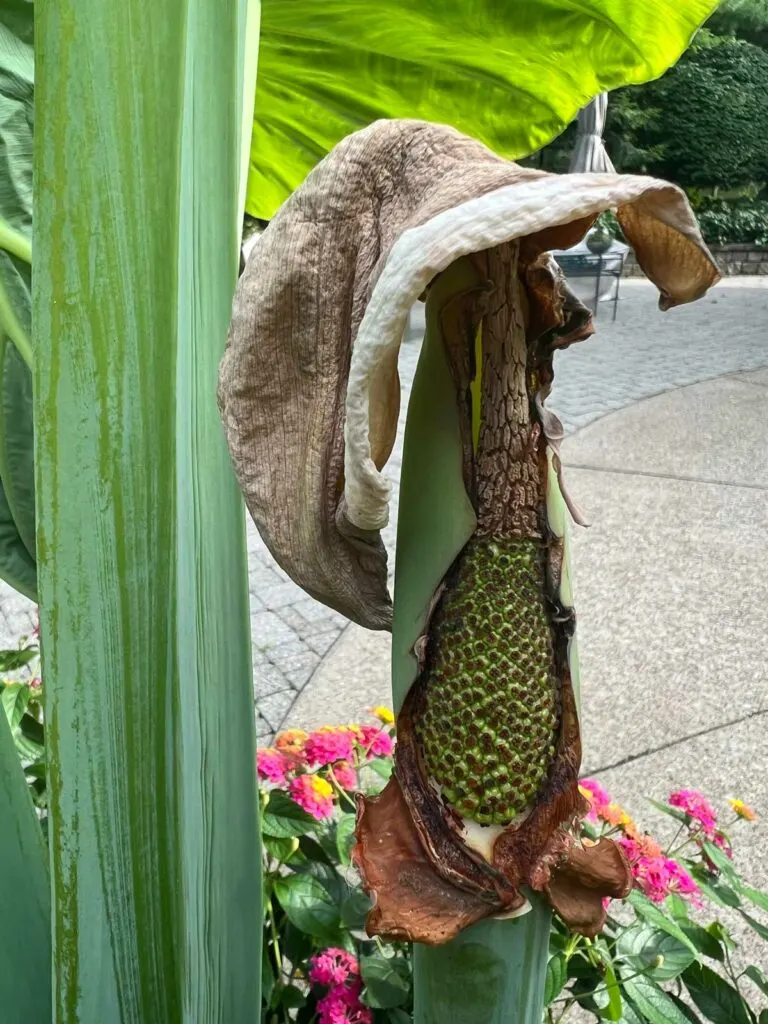
Fast forward another month to early October, my plant had produced 6 inflorescences!
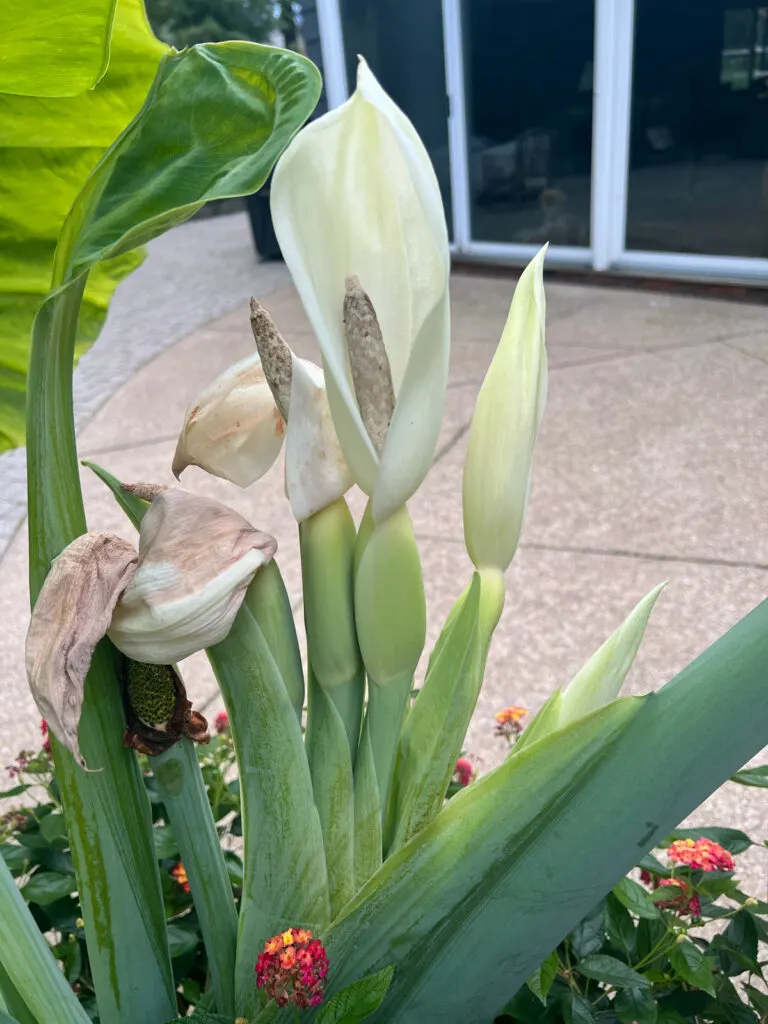
Do you have a Colocasia Thailand Giant? Comment below. I’d love to hear!


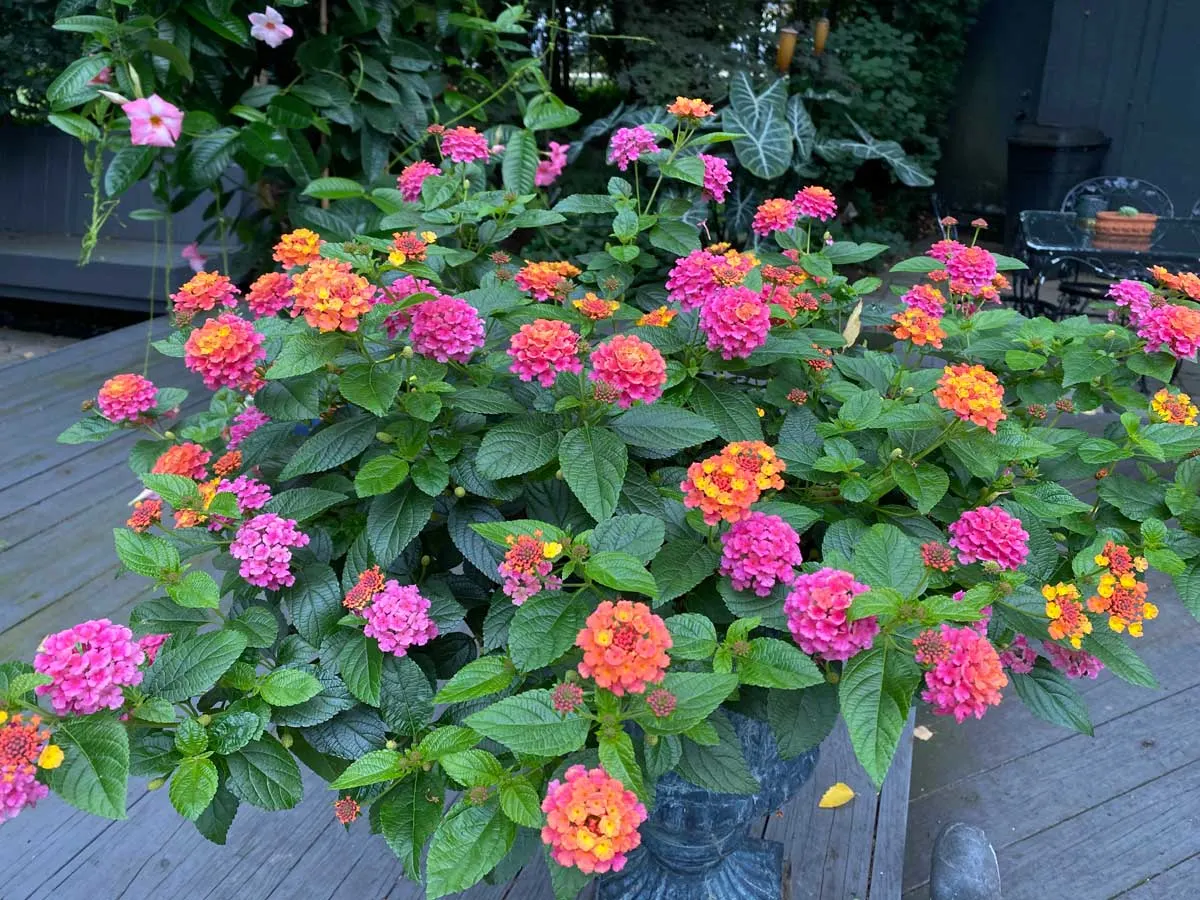
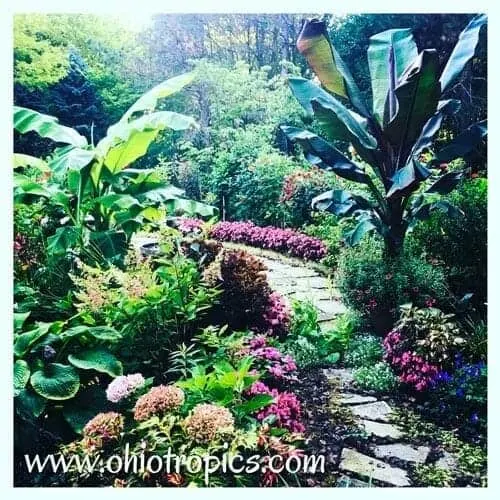
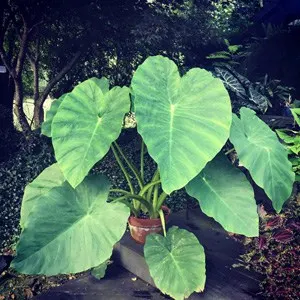
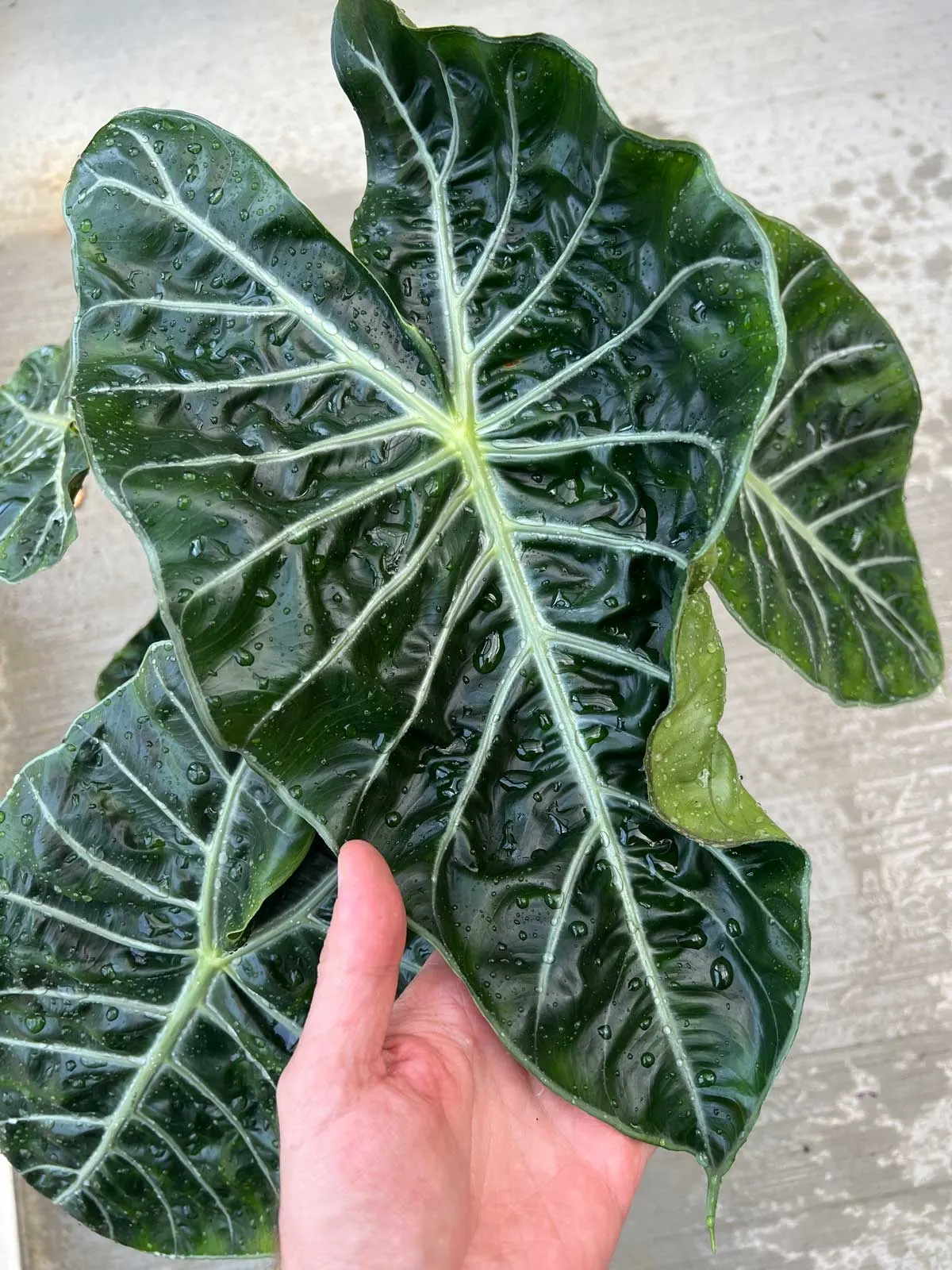
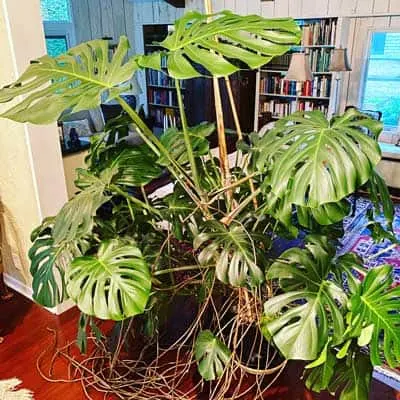
Sandy Burrell
Saturday 28th of October 2023
I grew these from seeds off mine I pollinated, in Indiana!
Raffaele
Saturday 28th of October 2023
Wonderful!!! Did you end up with a lot of plants?
Thao
Tuesday 19th of September 2023
I grow them yearly, mines are not as big as your though. Loving it, I use it in soup and salad.
Raffaele
Wednesday 20th of September 2023
They're definitely fun plants! :-) How do they taste? What part do you eat?
Hans-Olof
Sunday 17th of September 2023
Thanks for your good advices. Its my first year with Leucocasia gigantea. Im a bit worried for the winter and I really want them to survive inhouse. The problem is high temperature inside och snow and low temperature outside. 😂 Sweden isnt the best place for them I guess 😂
Raffaele
Monday 18th of September 2023
Hi Hans! I live in a cold winter climate too, but I think your winters are worse :-D Best of luck with your plant! You can try supplementing with a grow light, particularly during the winter time.
Tanya
Friday 18th of August 2023
Great read, love the pics! i just received my first Colocasia Thai Giant two days ago. It has two leaves with a third leaf emerging. I live in zone 3a so definitely keeping indoors until next summer. I'm thinking of keeping mine in a grow tent with humidity and heat. im hoping it will get to a decent size over winter then i can plant it in a larger pot outside next summer.
Raffaele
Friday 18th of August 2023
Glad you enjoyed my post, and good luck with your plant!
Ken
Wednesday 14th of June 2023
Thank you so much for all the info. I’ve had my plants for two years and I’ve kept them alive during the winter off to the side in a room that has had from 600 W HPS to 1000 W MH What do you suggest I do for the winter I read you just take the tube dry it out and then replant it? I am a quadriplegic and have other people be my hands and feet. Should I just keep them alive during the winter or is it best to do what you do? Also, is there a way to force them to make babies? I have a couple in pots that are 24 inches to 30 inches in diameter by 2 feet deep I do use a high porosity mix with sheep poop and feed organic flora nova veg, or miracle grow 20 2020 or is there should I be going with high nitro or high potash or phosphorous? And how do you tell a male from a female I’m a little confused I live in southwestern Ontario Canada
Thanks again Ken
Raffaele
Monday 19th of June 2023
Hi Ken! I think they are best if you can keep them growing, but you can also try to let them go dormant. A balanced fertilizer like you mentioned should be good! Each inflorescence actually contains both the male and female portions. Hope this helps a bit!